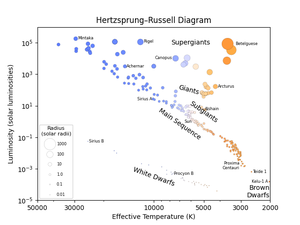Glossary term: Giant Star
Description: Giant stars, giants for short, are stars that are unusually large and luminous, compared with other stars that have the same color. Stars do not start out as giants; instead, they intermittently become giants at various stages of their evolution.
For most stars that are not giants, there is a direct relation between their color and their luminosity (that is, the energy they emit over time). Those stars are called "main sequence stars", and their energy emissions are powered by the nuclear fusion of hydrogen into helium in their cores. When the hydrogen supply in the core is exhausted, hydrogen fusion continues in a shell around the core and the star expands to become much more luminous and redder. Eventually the temperature in the center may be high enough that the nuclear fusion of elements heavier than hydrogen becomes possible, providing an additional energy source for the star. In the course of this conversion, such stars expand to a much larger size, cool down to become more reddish, and overall become much more luminous – they become what is known as red giant stars, red giants for short. The Sun, for instance, will be hundreds of times larger and brighter as well as much cooler when it expands to become a red giant star. For stars of different masses, additional, often short-lived phases of evolution sees those stars become blue giants, or even more luminous red or blue supergiants.
Giants are classified as luminosity class III, brighter than subgiants (class IV) but fainter that bright giants (class II) and supergiants (class I).
Overall, giant stars are rare. This is due to the relatively short duration of the giant phase (for a star like the Sun a few hundred million years vs ten billion on the main sequence). But given their high luminosity, they are significantly over-represented among the stars that are visible to the naked eye in the night sky.
Examples of red giants include Arcturus, in the constellation Boötes, and Mira, in Cetus.
Related Terms:
See this term in other languages
Term and definition status: This term and its definition have been approved by a research astronomer and a teacher
The OAE Multilingual Glossary is a project of the IAU Office of Astronomy for Education (OAE) in collaboration with the IAU Office of Astronomy Outreach (OAO). The terms and definitions were chosen, written and reviewed by a collective effort from the OAE, the OAE Centers and Nodes, the OAE National Astronomy Education Coordinators (NAECs) and other volunteers. You can find a full list of credits here. All glossary terms and their definitions are released under a Creative Commons CC BY-4.0 license and should be credited to "IAU OAE".
If you notice a factual error in this glossary definition then please get in touch.
Related Diagrams
Hertzsprung-Russell diagram
Credit: IAU OAE/Niall Deacon
License: CC-BY-4.0 Creative Commons Attribution 4.0 International (CC BY 4.0) icons









